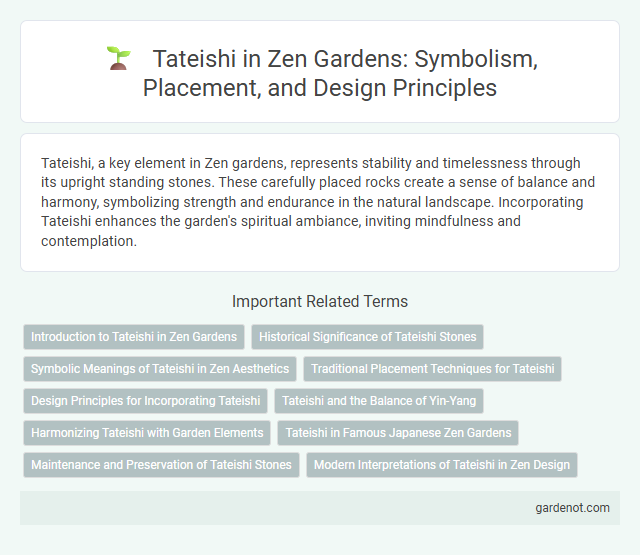Tateishi, a key element in Zen gardens, represents stability and timelessness through its upright standing stones. These carefully placed rocks create a sense of balance and harmony, symbolizing strength and endurance in the natural landscape. Incorporating Tateishi enhances the garden's spiritual ambiance, inviting mindfulness and contemplation.
Introduction to Tateishi in Zen Gardens
Tateishi, or "standing stones," are prominent features in traditional Zen gardens, serving as symbolic representations of mountains or natural landscapes. These carefully positioned stones create focal points that guide meditation and encourage contemplation within the minimalist design. The placement and form of Tateishi are meticulously chosen to evoke harmony, balance, and the essence of nature in Zen aesthetics.
Historical Significance of Tateishi Stones
Tateishi stones, prominent in Zen garden design, hold profound historical significance due to their use in ancient Japanese landscaping, symbolizing strength and endurance. These stones were strategically placed to evoke natural landscapes and spiritual balance, reflecting Zen Buddhist principles of simplicity and mindfulness. Their presence in traditional gardens offers insights into Japan's cultural and religious heritage, emphasizing harmony between human creativity and nature.
Symbolic Meanings of Tateishi in Zen Aesthetics
Tateishi, or standing stones, in Zen gardens represent strength, stability, and the enduring nature of the universe. These vertical stones symbolize the connection between heaven and earth, embodying spiritual awakening and the path to enlightenment in Zen aesthetics. Their deliberate placement fosters mindfulness and reflection, emphasizing simplicity and the profound beauty of natural forms.
Traditional Placement Techniques for Tateishi
Tateishi, or standing stones, in Zen gardens are traditionally placed to represent natural landscapes such as mountain peaks or islands, enhancing the garden's symbolic depth. Their positioning follows principles of balance and asymmetry to create visual harmony and evoke a sense of tranquility. Careful consideration of size, shape, and spatial relationships ensures that Tateishi integrate seamlessly into the garden's meditative environment.
Design Principles for Incorporating Tateishi
Tateishi, or standing stones, serve as focal points in Zen garden design, embodying principles of asymmetry and natural simplicity to evoke harmony with nature. Their placement follows the concept of "shakkei" (borrowed scenery), enhancing spatial depth and encouraging mindfulness through balanced yet irregular arrangements. Incorporating Tateishi requires careful consideration of scale, texture, and contrast to maintain the garden's tranquil and contemplative atmosphere.
Tateishi and the Balance of Yin-Yang
Tateishi, or "standing stones," play a crucial role in Zen garden design by embodying the balance of Yin and Yang through their deliberate placement and form. These stones symbolize Yang with their vertical, dynamic presence, counterbalancing the calm, horizontal elements representing Yin such as raked gravel or moss. This harmonious interplay of Tateishi and the surrounding features creates a meditative environment that reflects the fundamental Zen principle of equilibrium between opposing forces.
Harmonizing Tateishi with Garden Elements
Tateishi, or standing stones, play a crucial role in harmonizing Zen gardens by symbolizing mountains and natural strength, seamlessly integrated with surrounding raked gravel and meticulously placed moss. These stones establish a dynamic balance between earth, water, and sky elements, promoting tranquility and mindfulness. Their positioning follows traditional Japanese aesthetics, emphasizing asymmetry and natural placement to evoke a sense of timeless serenity.
Tateishi in Famous Japanese Zen Gardens
Tateishi, a prominent feature in famous Japanese Zen gardens, refers to large, carefully placed stones symbolizing strength and stability within the garden's minimalist design. These stones are often strategically positioned to guide contemplation and evoke natural landscapes in miniature form. The presence of Tateishi enhances the garden's spiritual ambiance, reflecting Zen principles of simplicity and harmony.
Maintenance and Preservation of Tateishi Stones
Tateishi stones in Zen gardens require meticulous maintenance to preserve their natural texture and aesthetic integrity. Regular cleaning using soft brushes and gentle water flow prevents moss buildup while avoiding damage to the stones' surface. Preservation efforts emphasize minimizing physical disturbances and controlling environmental factors to sustain the stones' symbolic presence in Zen garden design.
Modern Interpretations of Tateishi in Zen Design
Modern interpretations of Tateishi in Zen garden design emphasize the balance between natural stone placement and minimalist aesthetics, reflecting Zen principles of harmony and simplicity. Designers incorporate contemporary materials alongside traditional Tateishi, creating spaces that foster meditation while integrating urban environments. This fusion highlights the enduring spiritual significance of Tateishi, adapting its symbolism to modern architectural contexts.
Tateishi Infographic

 gardenot.com
gardenot.com